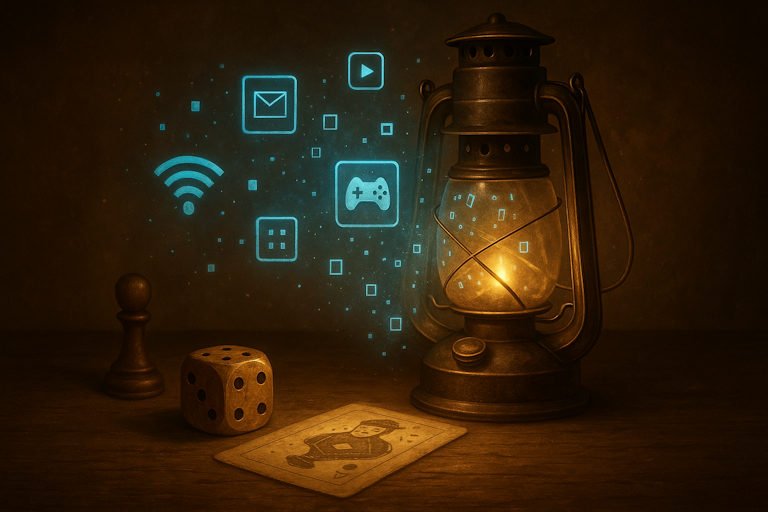
Are online games social? Surprising truths about meaningful connection and play (2025)
Are online games social — or are they a poor substitute for gathering in the same room? It’s a question many players, parents, and even researchers keep asking. The digital shift has transformed game nights, friendships, and how we connect across distance. For some, it feels liberating; for others, it feels isolating.
What makes this debate so engaging is that both sides hold some truth. Online games can be a place where friendships spark, communities thrive, and laughter flows as freely as it would at a real table. At the same time, screens can flatten human interaction, leaving out gestures, eye contact, and the small details that make social bonds feel tangible.
In this article, we’ll look at the evidence from both angles. We’ll explore how online play can build connection, where it falls short, and what you can do to make digital sessions feel more alive. Whether you’re a casual gamer or a host of virtual game nights, understanding the social side of online play will help you see not just what’s missing — but also what’s possible.
Are online games social? The case for connection
Are online games social in the way we usually think of play? In many cases, the answer is yes — but the connection looks different. Instead of gathering around a shared table, players log into platforms that let them cross distance and time zones. This shift doesn’t make the interaction less real; it just reframes how we experience community.
One of the strongest arguments for the social side of gaming is friendship. Online games often serve as the meeting ground for people who might never cross paths otherwise. Guilds, clans, and Discord servers function like modern town squares, where banter and teamwork build trust over time. For many players, these friendships extend far beyond the game itself — moving into daily chats, video calls, or even real-life meetups.
Teamwork also plays a crucial role. Multiplayer games require communication, coordination, and sometimes even conflict resolution. From casual puzzle games to massive role-playing worlds, success often depends on how well players cooperate. This builds skills that mirror face-to-face interaction: listening, negotiating, celebrating wins, and recovering from setbacks together.
There’s also an emotional benefit. In stressful times, playing online can provide a sense of belonging and support. Sharing laughter after a chaotic match or celebrating a clever win fosters the same dopamine rush as being together in person. For some, an online game night becomes a vital anchor — a ritual that creates routine and stability.
Finally, the accessibility of online play broadens its social reach. People separated by geography, mobility, or circumstance can join the same virtual table. What once required everyone to be in the same room can now happen across continents.
So yes, online games can be deeply social. They forge new kinds of relationships, shaped not by physical presence but by shared experiences and ongoing play. Connection takes a different form, but its impact is just as real.
Discover
the Firefly Inn
Behind its lantern light, mysteries unfold.
Step inside and choose your path

Where online games fall short socially
Even though the answer to are online games social can be a strong yes, there are limits to how far digital play can replace face-to-face interaction. The same features that make online games accessible can also make them feel thin or disconnected when compared to being in the same room.
One challenge is the absence of non-verbal cues. In a physical game night, so much is communicated through laughter, glances, or the way someone leans into the table. Online, these subtleties vanish behind muted microphones and pixelated screens. The lack of body language can lead to misunderstandings or a sense that something important is missing.
Another drawback is the rise of toxic behavior. Anonymity can embolden players to act in ways they never would offline. From trash talk to outright harassment, negative experiences can overshadow the social benefits. Communities often respond with moderation and rules, but the risk remains higher than in a group of trusted friends around a board.
There’s also the issue of isolation. Paradoxically, the very games designed to connect can deepen loneliness when players substitute them for in-person contact. A long night of online play can end with a sharp reminder of being physically alone in a room. For some, that contrast intensifies feelings of disconnection.
Technical barriers add to the frustration. Lagging internet, dropped calls, or failing headsets can interrupt flow and kill the mood. Instead of shared laughter, the focus shifts to problem-solving. While minor glitches can be handled gracefully, repeated issues erode the sense of presence.
Finally, online games often encourage quick drop-in sessions rather than the slower rhythms of traditional gatherings. The constant possibility of leaving or switching groups can make relationships feel less stable. Without continuity, bonds may remain surface-level.
In short, online play creates real opportunities for connection, but it also comes with risks and gaps. Recognizing these limitations helps us understand why some players feel that digital games, while fun, don’t always deliver the same depth of social experience.
Discover
the Firefly Inn
Behind its lantern light, mysteries unfold.
Step inside and choose your path

Quick considerations for making online play more social
Even if the question are online games social has mixed answers, there are simple ways to make digital play feel more connected. These practices don’t solve every limitation, but they set the stage for warmer and more engaging experiences.

- Choose the right platform. Stable audio and video tools reduce friction and keep attention on the group instead of the tech.
- Play with people you know. Toxicity is less likely when you gather friends, colleagues, or trusted players rather than open lobbies.
- Add small rituals. A shared toast, a recurring joke, or a “team snapshot” builds a sense of tradition across sessions.
- Keep groups small. Four to eight players is often enough for lively interaction without leaving anyone sidelined.
- Encourage voice over text. Hearing laughter and tone of voice brings warmth that written chat alone can’t capture.
- Blend digital with physical. Simple props like dice, cards, or even themed snacks anchor the experience in something tangible.
These adjustments don’t erase the limits of virtual play, but they soften the edges. By choosing carefully and adding a human touch, an online game night shifts from “just screens” to a shared experience that feels genuinely social.
Best practices to make online games social
If the question are online games social shows us anything, it’s that the answer depends on how we play. The tools and platforms matter, but the real difference comes from the way people approach the experience. With a few best practices, digital play can feel just as engaging as meeting around a table.
Prioritize communication. Voice chat should be the norm, not the exception. Tone, laughter, and encouragement bring warmth that text alone can’t deliver. For groups that prefer structure, set simple ground rules — like no multitasking and muting only when needed — to keep conversations flowing.
Create consistent gatherings. A one-off session can be fun, but repetition turns play into tradition. Weekly or monthly schedules give players something to anticipate, and rituals — a sign-off phrase, a rotating host, or even a shared playlist — weave continuity into the experience.
Foster inclusivity. Not everyone joins with the same comfort level. A good host keeps an eye on quieter voices, invites them in, and balances dominant players. Rotate roles so that responsibility and spotlight are shared. This prevents the dynamic from drifting toward hierarchy or exclusion.
Blend the digital and the physical. A subtle prop — rolling real dice on camera, showing a themed snack, or holding up a card — bridges the gap between screens and reality. These anchors remind everyone that they’re still playing together, not just clicking buttons in isolation.
Ultimately, the answer to are online games social is not fixed. The potential is there, but it depends on the culture players create. With thoughtful choices, online play can shift from a solitary pastime to a living, breathing community.
Conclusion – Are online games social or not?
So, are online games social in the way that in-person gatherings are? The truth is layered. Digital play can both connect and isolate, depending on how it is set up, who is involved, and the culture a group creates. What’s clear is that online play has the potential to be deeply social — but it requires more conscious effort than simply showing up at the same table.
On the positive side, online games can spark friendships that cross continents, create rituals that bring stability, and build teamwork skills that mirror real-world cooperation. For many, an online game night becomes a lifeline — a rhythm of laughter, inside jokes, and shared challenges that make distance feel smaller.
At the same time, the drawbacks cannot be ignored. Screens flatten body language, anonymity can fuel toxic behavior, and technical barriers can turn joy into frustration. Left unchecked, these gaps leave players feeling disconnected, even if the chat is full of voices.
That’s why the question are online games social is best answered with a “yes, if.” Yes, if players use platforms that encourage voice and video. Yes, if groups keep numbers manageable and prioritize inclusivity. Yes, if small rituals transform a random session into something meaningful. In other words: the social value of online games is real, but it depends on intention.
Ultimately, online games are not inherently more or less social than their offline counterparts — they are simply different. By leaning into practices that emphasize connection, we can make digital play not just a substitute for in-person gatherings, but a unique and powerful way of being together.
Discover
the Firefly Inn
Behind its lantern light, mysteries unfold.
Step inside and choose your path





